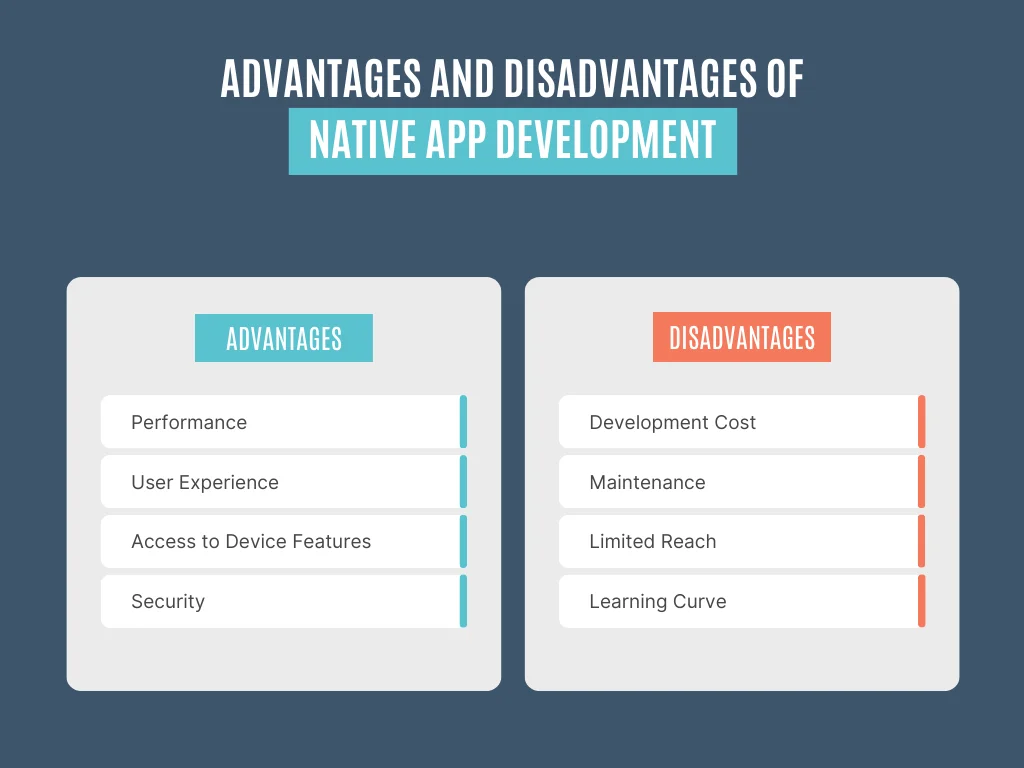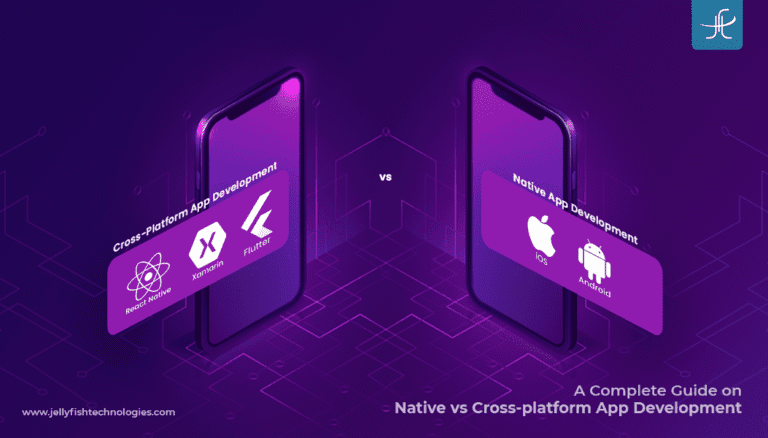Ever wondered about the staggering number of apps created and downloaded each day?
Let’s delve into some eye-opening statistics:
- In 2023, the global app and game downloads surged to a remarkable 148.2 billion, marking a notable 3.9% increase compared to the previous year’s figures (Source: Business of Apps)
- During the third quarter of 2022, Android users were able to choose between 3.55 million apps, making Google Play the app store with the biggest number of available apps. The Apple App Store was the second-largest app store with roughly 1.6 million available apps for iOS (Source: Statista)
- The global mobile application market size was valued at USD 228.98 billion in 2023 and is expected to grow at a compound annual growth rate (CAGR) of 14.3% from 2024 to 2030 (Source: Grand View Research)
When planning to develop an app, it’s crucial to select the appropriate development technology to ensure your app stands out. Whether you opt for a native, hybrid, or cross-platform approach, each has its own set of advantages and disadvantages, which vary based on the nature of your project.
In this blog, we aim to provide insights into native app development and cross-platform app development, helping you determine the best fit for your needs. Let’s begin by understanding the meaning of each approach.
What is Native App Development?
Native app development refers to the process of creating applications specifically designed to run on a particular platform or operating system, such as iOS or Android. These apps are developed using platform-specific programming languages, tools, and SDKs (Software Development Kits) provided by the respective platform vendors.
Native development involves leveraging the native capabilities and features of a particular platform to deliver high-performance, responsive, and user-friendly applications. By utilizing platform-specific APIs (Application Programming Interfaces) and SDKs, native apps can seamlessly integrate with device hardware and software, providing an optimized user experience.
One key aspect of native mobile app development is the use of platform-specific programming languages. For iOS development, developers typically use Swift or Objective-C, while Java or Kotlin is commonly used for Android development. These languages enable developers to harness the full power of the platform and access native APIs to create feature-rich and robust applications.
Another important consideration in native app development is the adherence to platform-specific design guidelines and user interface components. By following the design principles recommended by Apple and Google for iOS and Android, native apps can provide users with a consistent and intuitive user experience that feels native to the platform.
In summary, native app development involves building applications tailored to a platform, utilizing platform-specific programming languages, tools, and design guidelines to deliver high-performance, responsive, and user-friendly mobile experiences.
Advantages and Disadvantages of Native App Development
Advantages of Native App Development:

| Performance | Native apps are known for their superior performance and responsiveness. By utilizing platform-specific APIs and optimizations, native apps can deliver fast and fluid user experiences, even with complex functionalities. |
| User Experience | Native apps provide users with a seamless and intuitive experience that feels native to the platform. By adhering to platform-specific design guidelines, native apps can offer a consistent and familiar user interface, enhancing user satisfaction and engagement. |
| Access to Device Features | Native development allows direct access to device hardware and software features, such as camera, GPS, accelerometer, and push notifications. This enables developers to create rich and interactive experiences that leverage the full capabilities of the device. |
| Security | Native apps are typically considered more secure than other development approaches. By leveraging platform-specific security features and encryption mechanisms, native apps can protect user data and transactions from potential threats. |
Disadvantages of Native App Development:
| Development Cost | Building native apps for multiple platforms can be costlier and more time-consuming compared to cross-platform or hybrid development approaches. This is due to the need for separate codebases, development environments, and skill sets for each platform. |
| Maintenance | With native development, maintaining separate codebases for each platform requires additional resources and effort. Any updates or changes need to be implemented separately for each platform, leading to higher maintenance overhead. |
| Limited Reach | Native apps are platform-specific, meaning they can only run on a single platform. This can limit the potential audience reach compared to cross-platform apps, which can target multiple platforms with a single codebase. |
| Learning Curve | Developing native apps requires proficiency in platform-specific programming languages, tools, and SDKs. This can pose a steep learning curve for developers who are new to a particular platform or language, leading to longer development times and potential skill gaps. |
Popular Native App Development Frameworks
Several popular frameworks and tools are available for native app development, each offering unique features and advantages.
iOS/iPhone Development:
1. Swift
Swift is a modern and powerful programming language developed by Apple for iOS, macOS, watchOS, and tvOS development. It offers concise syntax, strong typing, and performance optimizations, making it an ideal choice for building native iOS apps.
2. UIKit
UIKit is a framework provided by Apple for building user interfaces in iOS apps. It provides a set of pre-built UI components, such as buttons, labels, and views, as well as APIs for handling user interactions and navigation.
Jellyfish Technologies Facilitated Corporate Cabs’ Operations By Developing An Android App Integrated With Their Point-Of-Sale (POS) Terminals.
Android Development:
1. Java
Java is a widely used programming language for Android app development. It offers platform-specific APIs and libraries for building native Android apps with access to device features and functionalities.
2, Kotlin
Kotlin is a modern and expressive programming language developed by JetBrains and officially supported by Google for Android development. It offers concise syntax, null safety, and interoperability with existing Java code, making it a preferred choice for many Android developers.
Curious about the differences between Java and Kotlin for Android app development? Explore our blog, ‘Java vs Kotlin: The Best Framework for Android App Development,’ to discover which framework suits your project needs best.
What is Cross-Platform App Development?
Cross-platform app development refers to the approach of building mobile applications that can run on multiple platforms, such as iOS, Android, and Windows, using a single codebase. Unlike native app development, which requires separate codebases for each platform, cross-platform development allows developers to write code once and deploy it across multiple platforms, saving time and resources.
Cross-platform apps are typically developed using frameworks and technologies that facilitate code sharing and platform abstraction. These frameworks provide tools and APIs that enable developers to create applications with a consistent user experience across different platforms.
One of the key concepts in cross-platform app development is the use of platform-independent languages and tools. By using languages like JavaScript, TypeScript, or C#, along with cross-platform development frameworks, developers can write code that can be compiled or interpreted to run on different platforms, without the need for platform-specific modifications.

Popular cross-platform development frameworks include React Native, Xamarin, Flutter, and Ionic, each offering unique features and advantages for building cross-platform apps.
Advantages and Disadvantages of Cross-Platform App Development
Advantages:
| Code Reusability | One of the primary benefits of cross-platform app development is code reusability. Developers can write code once and deploy it across multiple platforms, saving time and effort compared to developing separate codebases for each platform. |
| Cost-Effectiveness | Cross-platform development can be more cost-effective than native development, as it requires fewer resources and less development time. By leveraging a single codebase and development team, businesses can save on development costs and achieve faster time-to-market. |
| Consistent User Experience | Cross-platform app frameworks often provide tools and APIs for creating a consistent user experience across different platforms. By adhering to platform-agnostic design principles and UI components, developers can ensure that their apps look and feel consistent, regardless of the underlying platform. |
| Broader Market Reach | Cross-platform apps can target multiple platforms with a single codebase, allowing businesses to reach a broader audience across different devices and operating systems. This can help increase market penetration and user adoption rates. |

Disadvantages:
| Performance | Cross-platform apps may suffer from performance issues compared to native apps, as they often rely on intermediary layers or runtime environments to achieve platform abstraction. This can result in slower performance and reduced responsiveness, particularly for complex or graphics-intensive applications. |
| Limited Access to Platform-Specific Features | Cross-platform app development frameworks may not provide access to all platform-specific features and APIs, limiting the functionality and capabilities of cross-platform apps compared to native counterparts. Developers may need to use platform-specific plugins or extensions to access certain features, which can introduce complexity and compatibility issues. |
| Dependency on Third-Party Frameworks | Cross-platform app development often relies on third-party frameworks and tools, which may introduce dependencies and compatibility concerns. Changes or updates to these frameworks can impact the stability and maintenance of cross-platform apps, requiring ongoing maintenance and updates to ensure compatibility with new platform releases. |
| Learning Curve | Learning to develop cross-platform apps requires familiarity with platform-independent languages, frameworks, and development tools, which may pose a learning curve for developers new to cross-platform development. Additionally, maintaining proficiency in multiple technologies and frameworks may require additional training and resources. |
Popular Cross-Platform App Development Frameworks
1. React Native
Developed by Facebook, React Native is an open-source framework for building cross-platform mobile apps using JavaScript and React. It allows developers to write code once and deploy it across multiple platforms, while still providing a native-like user experience.
2. Xamarin
Acquired by Microsoft, Xamarin is a cross-platform development framework for building native iOS, Android, and Windows apps using C# and . NET. It enables code sharing between different platforms, while still providing access to platform-specific features and APIs.
Interested in learning the different benefits of using Xamarin for your app development projects?
You may find this blog useful: Top Reasons to Choose Xamarin for Cross-Platform App Development
3. Flutter
Developed by Google, Flutter is an open-source UI toolkit for building natively compiled applications for mobile, web, and desktop from a single codebase. It uses the Dart programming language and provides a rich set of pre-built UI components for creating beautiful and responsive apps.
Looking for Reliable Native Mobile App Development Services?
Upgrade and modernize your legacy mobile applications to deliver advanced digital experiences, enhance agility and improve market responsiveness.
4. Ionic
Ionic is a popular open-source framework for building cross-platform mobile apps using web technologies such as HTML, CSS, and JavaScript. It provides a set of UI components and tools for creating native-like user interfaces, as well as integration with popular front-end frameworks like Angular and React.
Ready to make an informed decision for your next cross-platform mobile app project? Dive into our comprehensive comparison of Flutter, Ionic, React Native, and Xamarin to find out which framework suits your needs best!
Native App Development vs Cross-Platform App Development
Each of these development technologies has its unique characteristics. Let’s determine the best fit for your needs by comparing them across various parameters.
| Project Requirements | Native App Development | Cross-Platform App Development |
|---|---|---|
| Performance | Offers superior performance due to platform-specific optimizations | May experience slightly compromised performance due to abstraction layers and framework overhead |
| User Experience | Provides a native look and feel, adhering to platform-specific design guidelines | Ensures a consistent user experience across platforms, but may lack certain platform-specific design elements |
| Access to Device Features | Enables full access to platform-specific features and APIs | Provides access to a wide range of device features, but may have limited access to some platform-specific features |
| Development Time | Typically requires longer development time due to the need for separate codebases for each platform | Offers shorter development time with code sharing across platforms, leading to faster time-to-market |
| Cost | Involves higher development costs due to the need for separate development efforts for each platform | Tends to have lower development costs as code can be shared across platforms, reducing the need for separate development efforts |
| Market Reach | Limits the app to a single platform, potentially reducing market reach | Expands the app’s market reach by targeting multiple platforms with a single codebase |
| Maintenance | Requires separate maintenance efforts for each platform, leading to increased maintenance overhead | Streamlines maintenance efforts with a shared codebase, reducing maintenance overhead and ensuring consistency across platforms |
| Learning Curve | Requires developers to have platform-specific skills and knowledge | Provides a more unified development experience, requiring developers to become familiar with one framework for multiple platforms |
| Popular Frameworks and Tools | Commonly used frameworks include Swift, Java, Kotlin, and UIKit | Popular frameworks include React Native, Xamarin, Flutter, and Ionic, offering code-sharing capabilities and cross-platform support |
Develop Your Native and Cross-Platform Apps with Jellyfish Technologies
When it comes to choosing between native app development and cross-platform app development, Jellyfish Technologies offers comprehensive solutions tailored to your specific needs. With our expertise in native and cross-platform development, we are well-equipped to guide you through the intricacies of each approach and help you make the best decision for your project.
Partnering with Jellyfish Technologies means gaining access to a team of seasoned professionals who are dedicated to delivering top-notch apps that meet and exceed your expectations. Whether you opt for the performance and optimization of native development or the versatility of cross-platform solutions, we have the knowledge and experience to bring your vision to life.
So, why settle for anything less?
Develop your native and cross-platform apps with Jellyfish Technologies and embark on a journey of innovation and success in the ever-evolving world of mobile app development.


